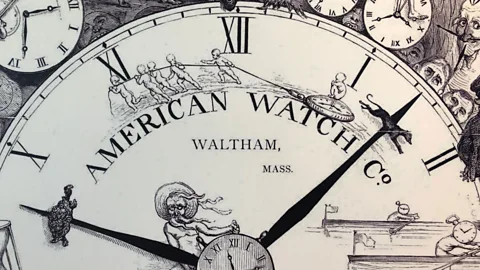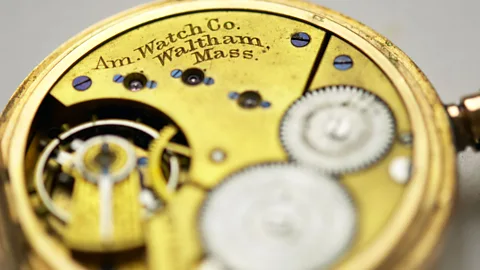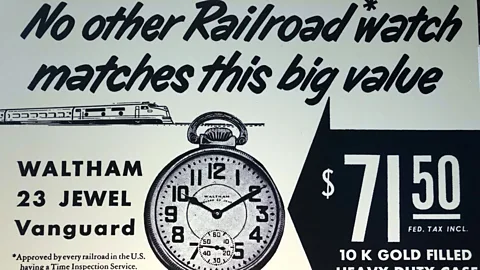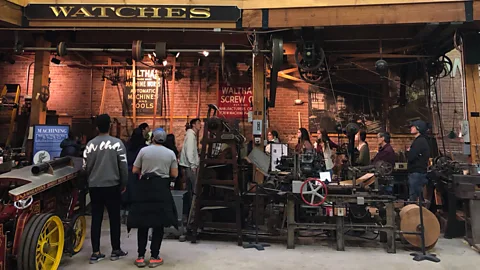The Massachusetts city that sold time to the world
 Linda Laban
Linda LabanKnowing what time it is might be something we take for granted now. But Waltham’s watch industry made it possible for everyone around the globe to know the correct time at a glance.
I was late. Not too late, I thought, but later than I had allowed to catch a train at London’s St Pancras station, on which I had booked a non-refundable seat to Derby. Adrenalin pulsing, I ran to the gate and saw my train was there. But I couldn’t get on board: the train’s doors had been automatically locked at its scheduled departure time and the gate to the platform was barred.
“I’m only a minute late,” I implored to the guard, to no avail. One minute, give or take several seconds: just when did time become such a precise affair that a minute late is too late?
The answer lies across the Atlantic in the city of Waltham, Massachusetts, where, in the mid-1800s, the Waltham Watch Company not only put the US and its railways on time, it helped put the world on time, too.
 Linda Laban
Linda LabanYou may also be interested in:
Though Waltham was a centre for several industrial and technological trailblazers – from the Boston Manufacturing Company’s textiles to the Metz motorcar – the city is known as ‘The Watch City’ and its seal sports the image of the Waltham Watch Company’s factory.
Until the mid-19th Century, watches were made individually using non-uniform parts manufactured in different locations – a process that was imprecise, time-consuming and expensive. As a result, only the wealthy could afford watches, and no two timepieces could be relied on to tell the exact same time. Then one ambitious company set up in Waltham and revolutionised the watch-making industry, using trial, error and ingenuity.
 Holcy/Getty Images
Holcy/Getty ImagesIt all began when Aaron Lufkin Dennison, a Boston watchmaker with a keen, inquiring mind, visited the Springfield Armory in south-western Massachusetts. Inspired by the efficiency and precision engineering of armaments manufacture, Dennison set about applying the armory’s methods to watchmaking, adopting similar subdivision of labour and creation of interchangeable parts that could be used in the same watch model, just as they were in the same model of gun.
With some wealthy investors convinced, Dennison set up the Boston Watch Company in the Boston suburb of Roxbury, before renaming it the American Watch Company and moving to Waltham in 1854, where its name would eventually settle as the Waltham Watch Company (WWC).
Dennison had created the first American manufacturing company to use assembly line techniques for making timepieces. The resulting mass production reduced the cost of a pocket watch, while the precision engineering excellence resulted in the then-most accurate clocks and watches on the planet, putting everyone on the same time and creating a connected world that has marked similarities to that of the internet revolution. Dennison’s vision was to create accurate time measurement – the correct time, all the time – and he succeeded.
 Andrew Barnes/Alamy
Andrew Barnes/AlamyWaltham’s industrial history notably began in the early 1800s with Francis Cabot Lowell’s Boston Manufacturing Company, which literally copied English textile production to cut yet another tie with the old colonial masters and create American cloth.
The Francis Cabot Lowell Mill building now comprises artist lofts and senior housing, along with the Charles River Museum of Industry and Innovation (CRMII). Each May, The Watch City Steampunk Festival celebrates the Victorian steam driven-era, and the museum appropriately s in. Among the museum’s industrial revolution artefacts, the section devoted to the Waltham Watch Company is a notable and permanent display.
“We have watches, of course, but also watch parts, tools and some of the very first machines ever made to manufacture watch parts,” said Bob Perry, the CRMII’s executive director. “It was effectively committing to interchangeable parts that was the Waltham Watch Company’s most distinctive innovation, and what made them the most important watch company of the 19th Century,” he added.
 Linda Laban
Linda LabanSome three-quarters of a mile along the Charles River from the CRMII, the Waltham Watch Company’s original factory on Crescent Street is where this all took place.
Nowadays, the Charles River is a recreational resource, not an industrial one, and its gushing waters still link the Cabot Lowell Mill and the Waltham Watch Company’s factory. I followed the Charles River Walkway from the museum’s main entrance, past the footbridge by the river’s bend where a waterfall impressed in its noisy, natural force, and into the Riverwalk Park where the Charles widens. Across the river from here is the Waltham Watch Company’s handsome factory, which still stands, good as new.
The long, turreted, red-brick building includes an Italianate central bell tower and walls of windows, the latter essential to light the watchmakers’ work benches before electricity. Now also loft apartments and businesses, a chic Italian restaurant anchors one end while at the other is the Waltham Watch Company exhibit, a CRMII satellite installation of instruments, timepieces, advertising posters and photographs of company workers of yore.
 Linda Laban
Linda LabanModern-day Waltham is packed tight with homes and businesses, but a diorama of the Cabot Lowell Mill site at the CRMII shows the area in 1825 when only the Boston Manufacturing Company’s factories and newly built workers’ homes sat among farmland. In the 1700s, this bucolic setting encouraged wealthy Bostonians to build magnificent (and now open to the public) country retreats like Gore Place, the Lyman Estate and Stonehurst, the Robert Treat Paine Estate.
And it was this natural setting that initially brought 19th-Century industry to Waltham: firstly, for that natural drop in the Charles River by the footbridge, which could be used for hydropower. Besides power though, Dennison’s meticulous precision engineering required clean air free of city soot. Such adherence to perfection soon trounced American watch-making competitors such as Elgin Movement, Hamilton and Illinois in both quality and precise time keeping.
“There was nothing like a Waltham watch for precision,” said Amy Green, PhD, CRMII’s resident historian. “The Waltham name, until the 1940s, had more cachet than any other watch. It was the iPhone of its day. Who wouldn’t want a Waltham watch?” she exclaimed.
Oddly, the American Civil War in the 1860s boosted the brand, when an affordable Waltham model became popular with Union troops. “In 1861, a watch movement, named the William Ellery, became known as the ‘soldiers watch’,” Green writes in her Trenches and Timepieces essay. It didn’t hurt that President Abraham Lincoln also owned Waltham watch. After years of trial and error that almost bankrupted the company, watch ownership had crossed socioeconomic demographics.
![James Taylor/Alamy Amy Green, PhD: “[The Waltham watch] was the iPhone of its day” (Credit: James Taylor/Alamy)](https://ichef.bbci.co.uk/images/ic/480xn/p06sxhhj.jpg.webp) James Taylor/Alamy
James Taylor/AlamyAffordable and accurate, the Waltham Watch Company became a world leader in timepiece manufacturing, so superior and successful that, according to Marty Cohen, a horologist and historian who helped create the CRMII’s Waltham Watch Company display, Swiss watchmakers were said to have sent spies to Waltham to glean information on its engineering and production. They failed and began making what have become known as ‘Swiss fakes’, Cohen explained: replicas that looked like a Waltham but didn’t work like one. “They tried to them off as Walthams and would even use dials that said ‘Walham’ or something that looked similar,” he said.
“By the 1890s, [the Waltham] was the most precise watch in the world,” Green said. “Every railroad on every line in the US had them to time trains. The level of precision meant greater safety. They remained the industry leader to be trusted.”
But as the industrialised world required ever more ways to synchronise time keeping, the Waltham Watch Company failed to keep up.
“They revolutionised and democratised watch making but remained committed to the fob pocket watch,” Green said. “Fob watches became more affordable, but became unpopular because it took time to take it out of the pocket, and the wristwatch rose.”
It was another war, World War Two, when the factory’s production was dutifully switched to the military with precision instruments, that eventually proved the final nail in the Waltham Watch Company’s coffin – and, ironically, Swiss watchmakers had the last laugh.
“In the war years, no watches were made by Waltham for civilians,” Cohen said. “It was military watches and navigational instruments; gyros and other precision instruments. So, who supplied civilian watches during World War Two?” he asked. “The Swiss.”
 Linda Laban
Linda LabanUntil the company’s demise in 1957, more than 40 million precision instruments, including watches, clocks, speedometers, comes and time fuses, were produced at the Waltham factory. And they were produced on machines installed in the mid-1800s.
“After the war was over, the watchmakers at Waltham went to the board of directors and asked them to invest more money,” Cohen said. “The machines were worn; their tools were old. But the board was convinced the company already made the best watches in the world and said no.”
Bankruptcy befell the company; it was sold and operations moved to Switzerland. Still, those parts and instruments made long ago in Waltham remain revered. In 2013, Colorado-based Vortic Watch Company began making wristwatches using antique American pocket watch parts sourced from pawnshops and scrap piles. A Vortic Waltham was inducted into the CRMII's Waltham Watch Company exhibit in 2016.
“The Waltham Watch Company was one of the first to make pocket watches on a mass scale, but they were less concerned with trends and more interested in making the best,” said Vortic co-founder RT Custer. “The engineering is much better than a lot of the watches made today.”
 Linda Laban
Linda LabanIn an interesting twist, three residents at the Watch Factory Lofts have bought Vortic Waltham watches. “We delivered each to the factory; shipping it back to the place where they were first made and coming full circle,” Custer said. “People don’t need a watch; we have our phones. I think of what we do as turning back time and taking these parts made 100 years ago and making them work again.”
Back on that day at St Pancras, when precision timing seemed a devastating incursion on my plans, the benevolent guard explained that without it the station would be in chaos. He kindly stamped my ticket, allowing me on the next train, with a polite warning: “Just don’t be late for that one.”
Places That Changed the World is a BBC Travel series looking into how a destination has made a significant impact on the entire planet.
more than three million BBC Travel fans by liking us on Facebook, or follow us on Twitter and Instagram.
If you liked this story, sign up for the weekly bbc.com features newsletter called "If You Only Read 6 Things This Week". A handpicked selection of stories from BBC Future, Earth, Culture, Capital and Travel, delivered to your inbox every Friday.
{"image":{"pid":""}}
